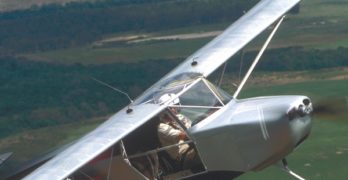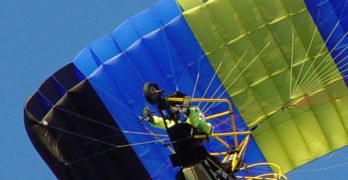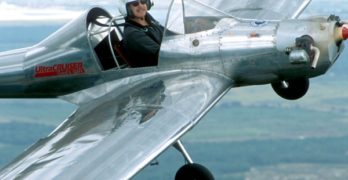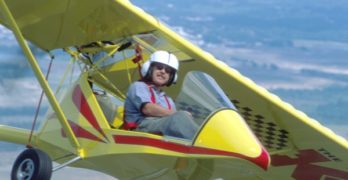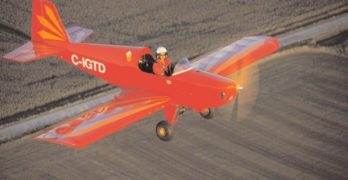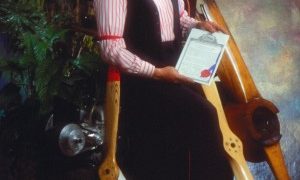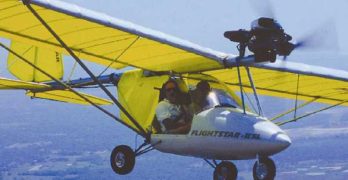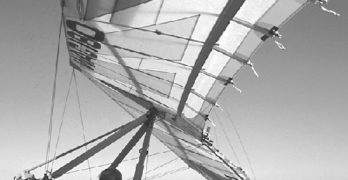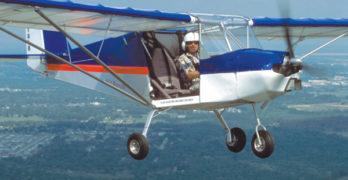Engineering design is usually an evolutionary process. While occasionally a breakthrough idea comes to market, most development in aviation is a result of small steps. The Escapade is a good example.
Once Flying K Enterprises (now Sky Raider LLC) offered their Sky Raider. The single-seater had much in common with the immensely popular SkyStar Aircraft Kitfox. In fact, when SkyStar offered their Kitfox Lite single-seater, Flying K built the welded fuselage for them.
Then came the Sky Raider II with a tight back seat that could be used for an occasional ride though not instruction as no controls were installed in the rear. The new Summit offered by Just Aircraft late last year was a variation on the Sky Raider II theme.
Company leadership changes as do their designs and the path from Flying K to Just Aircraft is convoluted; other business names are involved. By example, Rocky Mountain Wings, run by former Flying K partner Stace Schrader, offers their very similar Ridge Runner.
Search Results for : evolution
Not finding exactly what you expected? Try our advanced search option.
Select a manufacturer to go straight to all our content about that manufacturer.
Select an aircraft model to go straight to all our content about that model.
Gemini Powered Parachutes Come From Experience
According to the new Ultralight Flying! “Ultralight and Microlight Buyer’s Guide,” 24 companies are building powered parachutes in 2003. That figure doesn’t include recently announced foreign competitors and doesn’t count all that may follow. How does a new company stand out in such a crowd?
Gemini Industries boss Randy Snead is a well-known personality among powered parachute enthusiasts. He was the main technical person with Buckeye Industries, working with FAA personnel for months in pursuit of Primary Category certification. In blazing that new trail, Snead earned a reputation as being serious and knowledgeable.
His business enterprise is new to the scene, but given Snead’s long experience in this segment of light aviation, Gemini Industries should prosper. I see the company surviving any industry shakeout as the Indiana company keeps its overhead low and offers reliable products at low prices with reasonable delivery times. Gemini Industries isn’t flamboyant like some powered parachute producers and that’s exactly why Gemini’s formula should work.
Long-Lasting UltraCruiser Fun Plane
A Gift of Design
The UltraCruiser was born under rather unusual circumstances. Its designer, Morry Hummel, was not a young engineer with a passion for flying ultralights. On the contrary, Hummel is one of aviation’s pioneers with many years of experience. His story identifies how he found the time to create the UltraCruiser and, in particular, why the ultralight is fully named UltraCruiser, God’s Gift.
Hummel wrote, “I crashed my miniMAX on July 19, 1995. I lost my right leg below the knee, my left leg was badly broken, and my face crushed. My teeth were wired shut for 10 weeks and I was fed through a tube in my stomach.
“While I was in the hospital for 5 months, I had time to think. God had spared my life for a reason. The UltraCruiser is named God’s Gift because I am only 85 years young and flying again.”
I found it an inspiring story.
New Kolb’s FireStar, Flyer and Sport 600
Once Kolb’s FireStar was a new design; a second-generation evolution for the company then headquartered in Pennsylvania. The first Kolb single-seaters were later joined by the TwinStar, the company’s original 2-seater, all of which preceded the FireStar series.
Under the direction of Homer Kolb and Dennis Souder, the original Kolb Company followed their success with the FireStar by creating the Mark III 2-seater, FireFly single-seater, and SlingShot tandem 2-seater. They also worked on but never released the Laser.
In 1999 Bruce Chesnut and Brian Blackwood purchased Kolb Aircraft from Dennis Souder who, along with other partners had owned the enterprise since 1994. Chesnut and Blackwood renamed the company The New Kolb Aircraft Company and moved it to new facilities at the Chesnut Knolls Aviation Foundation Airpark in London, Kentucky.
The Kentucky-based company has focused on model revisions such as the Kolbra and King Kolbra, and the Mark III Xtra. Most recently, The New Kolb Aircraft Company has entered the powered parachute market with their Flyer, and to the proposed Light-Sport Aircraft segment with the Pelican Sport 600.
Murphy Aircraft Returns to Its Roots
After ever-bigger Rebels, the JDM – 8 is a genuine ultralight
Darryl Murphy’s commitment to
small plane design is evident
by the fact that during the
years when Murphy Aircraft Mfg. exhibited
in two locations at various
fly-ins, Darryl frequently was seen
working his company’s booth in the
ultralight area. Other Murphy Aircraft
staff members would be working the
Rebel/Super Rebel booth. At the Northwest
EAA Fly-In in Arlington,
Washington, this past summer, that
pattern re-emerged; the boss stayed
with the JDM-8 in the ultralight exhibit
area. In my conversations with
him, he seemed pleased to be presenting
a genuine ultralight again.
Those who know the history of
Murphy Aircraft before the first Rebel
arrived won’t be surprised to see the
company marketing an ultralight.
This Canadian manufacturer was an
ultralight company that expanded
into homebuilts and has achieved success
through their Rebel series. The
new single-seat JDM-8—especially
when contrasted with the huge, radialengine-
powered Moose—shows this
company has not forgotten its roots in
ultralight aircraft.
Chuck’s Patented Reduction Drive?
Chuck’s Patented Reduction Drive?
Back when ultralights were new, most engine/prop combinations were direct drive. General aviation aircraft engines are direct drive. Of course, these run at slower revolutions so the prop speed isn’t excessive. On a high-revving 2-stroke engine, direct-drive props (commonly 36-inch diameters) are spinning so fast the prop tips create a lot of noise.
When I owned and flew a Flight Designs Jet Wing trike back in 1982, that direct-drive Kawasaki 440 engine and prop were so loud my neighbors complained and I had to cease flying except during certain hours.
To the rescue came Chuck Slusarczyk and his invention. The funny thing is, his patent is not for the reduction drive as many think and as this sidebar’s title suggests.
Even before he designed his groundbreaking Hawk, Chuck developed and was the first to use an “ultralight” reduction drive. His early experience was during the days of experimentation of powered hang gliders.
Flightstar II SL
Since Tom Peghiny and partner Spark Lamontagne first lightened the Flightstar and named one model the II SL (for “Sport Light”), they haven’t been able to sit still and simply admire their work. From our first pilot’s report on the SL 3 years ago,1 the two have tweaked and adjusted the model to find even better qualities.
A new front and aft fairing are part of the package, and the latter you might notice rather quickly. Virtually all the rest of the improvements are subtle things. In fact, that word is a hallmark of Flightstar innovation.
No surprise then that the company should adopt “New and Improved” as its new advertising headline to assure you know about the changes.
Better and Better
I’ve followed the Flightstar from its first flight, when it wasn’t even the Flightstar. This design – which once crossed the Atlantic – is from the inventive mind of Swiss national Hans Gygax, and became the rather gaudy 440ST.
XP Racer
More than one European writer has called the single-seat Air Création Racer “the best ultralight in the world.” That’s a pretty big statement in a world full of wonderful recreational aircraft. Can it measure up? The short answer is, “Yes, very possibly it can!”
The best ultralight in the world? Really? Well, this is too sweeping a statement. No one knows which ultralight is truly the best because best is different for every person. What is best for you may not be best for me.
This very point has crystallized my response to many pilots who ask me at airshows, “You’ve flown everything. What should I buy?” I can’t answer the question because I don’t know what you want. Only after a lengthy conversation and watching you fly could I even hazard a guess about the best ultralight for you. Even then, it’s too likely I’d be wrong.
Nonetheless, some aircraft are clear winners and others aren’t so strong.
French Quick-Build 2 Seater
One of the most popular club planes in France is widely used by instructors in that country. Now we welcome the Sky Ranger to North American skies.
In France, as with much of Europe, many ultralights are owned by aero clubs which frequently manage recreational airfields throughout the continent. Run a little differently in each location, they provide common ways for average pilots to fly and for newcomers to be introduced to flight. Virtually all aero clubs provide instruction, often through associated flight schools. Clubs also own and maintain aircraft – lots of them. This has worked especially well with sailplanes; Europe has more than twice as many sailplanes as the United States and several times the pilot population. Ultralight enthusiasts have followed this example.
The Sky Ranger arrived in the mid-1990s at French ultralight aero clubs that dot the landscape, and has done very well. U.S. importer Sabre Aircraft says, “It’s the most popular ultralight in France, especially with the flight schools.” In more than just 6 years, the company claims deliveries of about 500 aircraft.
Titan Tornado
An Experimental ‘fighter jet’ that any pilot could love That vast majority of general aviation pilots who won’t even think about building their own plane has missed quite a revolution.
The FAA says approximately 25,000 aircraft are registered as Experimentals. That’s 15% of the GA fleet.
Building isn’t what it used to be. You no longer need to master the skill of reading engineering prints (plans), nor must you search high and low for parts.
These days, most registered Experimental aircraft are built from kits. Many are well-fabricated packages that can be assembled in just a few hundred hours. That can mean as little as two or three hours a night, two to three days a week, for about a half-year. Not a bad investment for a truly unique airplane.
One sport pilot who enjoys flying his creations is Minnesota resident Al Reay. For Reay, building is a means to an end.


